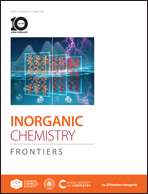Selective C–C coupling of two nitriles affording rare-earth diazametallacyclopentadienes: synthesis, cooperative reactivity and mechanistic studies†
Abstract
While the reductive coupling of two nitriles mediated by transition metals has been widely studied in the past ten years, the analogous process promoted by rare-earth metals remains elusive. Herein, we report the selective C–C coupling of two nitriles by rare-earth metal reduced naphthalene complexes to assemble the first authentic rare-earth diazametallacyclopentadienes. Mechanistic studies reveal that the reaction proceeds through the insertion–release–insertion sequence, which is different from the known oxidative cyclometallation process for transition metals. This provides an alternative mechanism for metal-mediated reductive coupling of two nitriles. Furthermore, reactivity investigation indicates that diazascandacyclopentadiene exhibits distinct 1,4-hydrogenation and insertion reactions toward H2, isothiocyanate, isocyanide, and W(CO)6 to give diversified rare-earth metallacycles. These results indicate that rare-earth diazametallacyclopentadienes present unique chemistry, which is different from that of group 4 diazametallacyclopentadienes.



 Please wait while we load your content...
Please wait while we load your content...